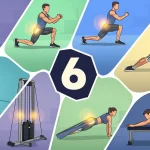Hello, Fit People! Before you dive into your workout, warming up is key to preparing your body for physical activity. One common method used is static stretching. Have you heard of this term? Let’s take a closer look at what static stretching is, its benefits, and some example movements you can try to optimize your workout performance.
What is Static Stretching?
Static stretching is a type of stretch performed by holding a position for a few seconds to minutes. Unlike dynamic stretching, which involves active movements, static stretching doesn’t require intense movement. You simply hold the stretch position for 15 to 60 seconds to give your muscles time to stretch and prepare for further exercise.
Static stretching is usually performed at the end of a workout as a cool-down, but it can also be done before exercise to help improve your body’s flexibility and mobility.
Benefits of Static Stretching
Doing static stretching has several important benefits, especially if you want to maximize your workout results. Here are some key advantages of static stretching:
1. Improves Muscle and Joint Flexibility
When you perform static stretching, your muscles undergo a deeper stretch. Good flexibility is essential to support optimal movement during workouts. With more flexible muscles, you’ll also reduce your risk of injury.
2. Helps Reduce the Risk of Injury
By giving your muscles time to adjust to the stretch position, static stretching helps minimize the risk of injury. The controlled and stable stretches make your muscles more prepared for heavier or more intense workout loads.
3. Promotes Muscle Relaxation and Recovery
In addition to physical benefits, static stretching helps calm the mind and body. It can be a great way to start or finish a workout with greater relaxation. Gentle stretches allow tight muscles to relax and recover more efficiently.
4. Improves Balance and Stability
Holding static stretch positions also engages your core muscles to maintain balance. By regularly practicing static stretching, you’ll notice improvements in overall body stability and coordination.
Example Static Stretching Movements
Curious about what static stretching movements you can try? Here are a few simple yet effective exercises you can incorporate before or after your workout:
1. Standing Quadriceps Stretch
Stand on one leg, pulling the other leg up toward your glutes with your hand. Hold this position for 30 seconds, then switch legs. This movement is great for stretching your quadriceps.
2. Seated Hamstring Stretch
Sit with one leg extended straight and the other bent. Reach for the toes of your extended leg and hold for 30 seconds. This movement stretches the hamstring muscles in the back of your thigh.
3. Triceps Stretch
Lift one arm overhead and bend the elbow so that your hand reaches behind your head. Use the opposite hand to pull the elbow toward your head. Hold for 30 seconds and repeat on the other side.
4. Butterfly Stretch
Sit with the soles of your feet touching in front of you and gently press your knees toward the floor while holding your ankles. Hold this position for 30 seconds to stretch the inner thighs.
5. Chest Stretch
Stand upright and clasp your hands behind your back. Pull your arms backward and feel the stretch in your chest. Hold for 30 seconds. This movement is great for stretching your chest and shoulders after an intense workout.
When Should You Do Static Stretching?
While static stretching is effective for improving flexibility, it’s best to do it after your body has warmed up. Ideally, you can start with dynamic stretching to increase your body temperature and blood flow, then move on to static stretching to enhance muscle flexibility.
However, static stretching is also perfect as part of your cool-down routine after a workout. It helps relieve muscle tension and promotes quicker recovery following an intense session.
Conclusion
By incorporating static stretching into your routine, you’ll improve your workout performance and protect your body from injury. So, don’t forget to add these stretches to your fitness regimen, Fit People! Have you tried any of the movements mentioned above? Share your experience in the comments!
Understanding the importance of static stretching is crucial in maintaining your body’s health and fitness. By knowing the definition, benefits, and movements, you’ll be more prepared to tackle your workout with peak performance. Start incorporating static stretching into your workouts today and feel the difference!





